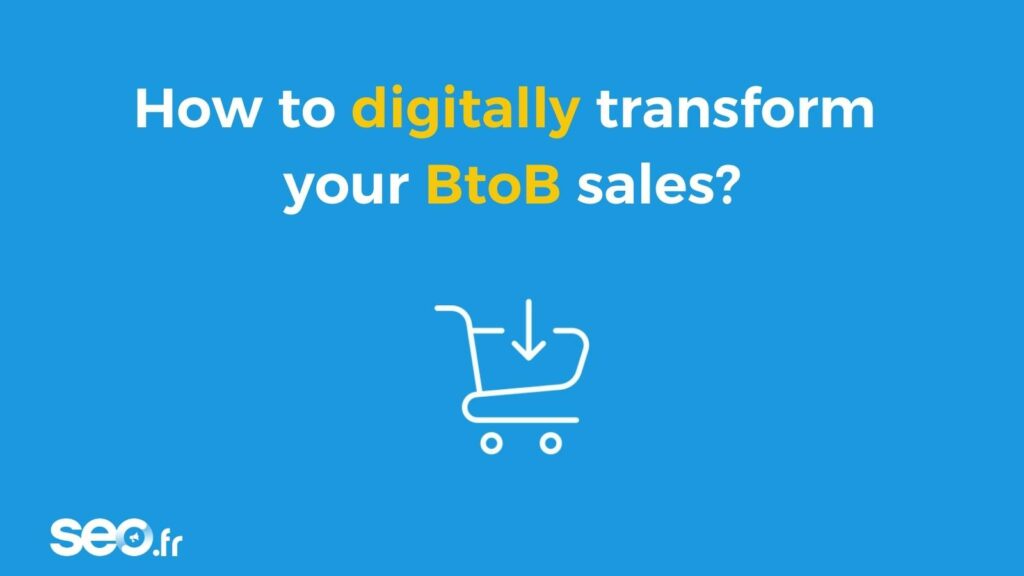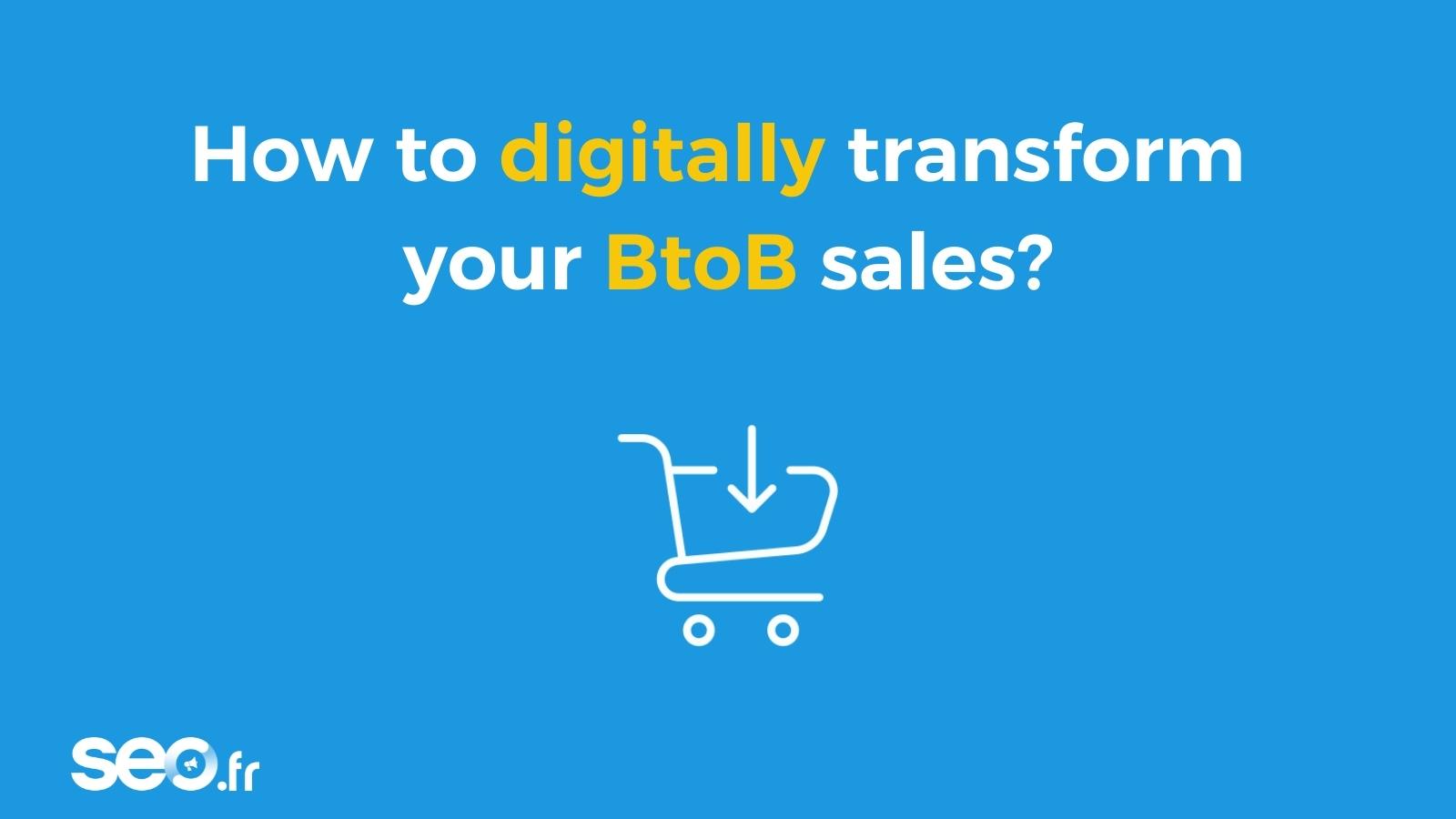Digital transformation of sales: Is it a real challenge for B2B companies?

With the democratization of new technologies, purchase behaviour has changed dramatically, and the same goes for business practices.
Sellers, in turn, must learn to use the full potential of digitalization to meet the new needs of their prospects.
The traditional business approach is no longer sufficient to attract new customers, and most are quickly annoyed by salespeople who incessantly try to sell customers products and services without knowing what their real needs are.
With the advent of the internet, prospects now have access to a large database on companies in order to form their own opinion. To attract these companies, taking care of their digital presence is crucial and has therefore become one of the major challenges that businesses face.
Sales now face new challenges, as some of their effective methods that have long been traditionally used have now become obsolete and no longer able to produce expected results.
But still, how can sales launch their digital transformation and perfect it with time? What tools do they have at their disposal to convince new prospects? What are the most effective practices for successful digital transformation?
The Vital Relationship between Sales and Technology in B2B

Used to the ever-changing technologies, millennials will represent 46% of future professionals. (source: business LinkedIn). It therefore goes without saying that, in order to remain effective, today’s salespeople must now adapt to these new purchasing behaviours.
According to a Benchmark conducted among 63 businesses (of which, 81% are in the B2B field for the majority of their business activities and 60% have more than 1000 employees), it was noted that 23 of these companies have identified sales as the first department which has been affected by digital transformation.
A real challenge for sales now is to succeed in achieving their objectives. In 2018, 65% of B2B businesses considered the productivity of their sales team as the most important. In fact, 2/3 of salespeople never reached their annual sales objectives, and 23% of businesses do not live up to say that their sales objectives are reached each year.
To compensate this, 60% of sales managers believe that the digitalization of sales would be crucially responsible for the success of their businesses.
Digitalization therefore opens up numerous opportunities to maintain the relationship of companies with their prospects. Technology makes it possible to remain connected 24/7, and this is perfectly suitable to retain customers and develop with them long-term deeper relationships.
One of the major challenges of the digital transformation of sales is therefore to provide a good-quality content to prospects, and this content caters for their needs throughout their reflection cycle. A personalized web experience would increase sales by 19%. (source: MarTechAdvisor).
According to a study of “the marketingmanagement” site, 67% of “the buyer’s journey” is now carried out online, even before the intervention of a salesperson. Prospects have massively integrated a digital aspect into their reflections upon purchasing. Sales must therefore take care of their companies’ digital presence.
84% of Internet users base their purchasing decisions upon what they read during an online search, upon social media comments or after consulting friends.
Another challenge to the digital transformation of sales is to make contact between companies and prospects easier. Back in 2018, taking a sales appointment takes 4 to 5 email exchanges to find a common niche with a prospect. Thanks to the digital transformation of sales, customers now simply fill in a contact request form at any time of their day. (source: leadgenerator)
81% of marketing and communications managers who were asked in a survey by TNS Sofres on “How (they) monitor (their) brands today” believe that taking digitalization and its consequences into consideration in customer relations and communication has become a priority challenge of the upcoming years.
In addition, prospects seeking to book a commercial appointment are often very well informed on the company’s products or services. They often expect more humanized and homogeneous sales relationship before and after selling products and services.
On average, 70% of companies that have well equipped their sales outlets with digital tools hope that they would increase productivity and promote their brand image during customer appointments. (source: touch-sell)
Nevertheless, providing advice has become no longer enough. Salespeople must be experts when dealing with a very specific request. According to marketingmanagement.com, a salesperson is 9 times more likely to convert a prospect if he or she understands and caters for needs in less than 5 minutes.
Here are the results of an infographic that was designed by Touch&Sell (on 161 salespeople surveyed, 65% of which are in B2B and 30% are in both, B2C and B2B), which highlight the importance of the digital transformation of sales in the upcoming years:
- 66% of salespeople have their sales assets equipped with sales digital support tools
- 82% of these have professional smartphones and 71% have tablets. Additionally, 40% of companies that equipped their salespeople with tablets consider this to have a direct impact on the number of sales.
- 90% of salespeople believe that digital tools improve satisfaction with sales force. 75% believe this improved customer satisfaction.
- More than 70% of the companies that equipped their salespeople with digital tools believe they have gained in productivity.
- 69% of companies believe that digital tools promote their brand image during customer appointments.
- 71% of users think that sales support tools provide real-time access to all commercial digital outlets.
- 62% of sales representatives consider digitalization to be capable of making business presentations more effective, 57% believe it optimizes sales management and 56% see that it enables salespeople to have access to customer profiles in a mobile situation.
What are the benefits of digitalization for sales?
With digitalization, sales are more effective and flexible, and relationships with prospects are strengthened. Digital transformation also saves time, since many actions can be automated, therefore leading to minimizing costs in the long run.

Here are 5 sales tips in order to make digital transition successful:
First, analyze the entire purchase journey of every sector and each product you are marketing. This will allow you not only to answer the slightest questions from prospects but also to establish your expert status.
Make sure that your business is digitally visible. This applies to the business website, social media, blogs as well as client reviews.
Bring credibility into your interactions. Internet users seek humanised relationships, and salespeople must reassure internet users and become available before starting the sales process.
Be fast and flexible throughout customers’ purchase journey. Adapt your approach to different personas and answer quickly to the customers’ needs.
Use all the media channels at the disposal of your company, whether via social networks, emailing campaigns or pop-ups on your website.
What are the major obstacles that the digital transformation of B2B sales faces?
Although most of the B2B companies have already started their digital transformation, some are encountering difficulties with digitizing their sales department.
This can be explained through several factors. The two main issues that hinder the digital transformation of sales are:
- In 37.5% of the cases, the cause is the internal resistance of the sales teams: either concerning new digital practices, or because the tools are not adapted to their needs, which can lead to frustration and decrease effectiveness.
- In 12.5% of the cases, it is due to the lack of support which leads to bad repercussions on the investment of the digital transformation of sales. (source: actionco)
The digital world is changing rapidly and constantly. Companies may therefore have difficulty transmitting certain sales techniques to their teams. These techniques are linked to multi-channel environments, and the digital tools associated to these techniques are numerous. Selecting tools adapted to your teams can often seem difficult without a good knowledge of digital practices.
Another difficulty that salespeople encounter throughout the digital transformation of their businesses is often the inability to manage the set of missions entrusted to them, and this is for a good reason, as they must not only perform well in administrative tasks (which represent 30 %, on average, of managers’ time) and learn new digital sales practices, but also respond to many performance indicators, both traditional and digital ones. On average, nearly 2/3 of managers must track on a daily basis more than 5 activity indicators. (source: actionco)
Another difficulty that salespeople encounter throughout the digital transformation of their businesses is often the inability to manage the set of missions entrusted to them, and this is for a good reason, as they must not only perform well in administrative tasks (which represent 30 %, on average, of managers’ time) and learn new digital sales practices, but also respond to many performance indicators, both traditional and digital ones. On average, nearly 2/3 of managers must track on a daily basis more than 5 activity indicators. (source: actionco)
Without a good training in digital practices and associated digital tools, sales are often overwhelmed by all these changes and new methods of practice.

Another factor delaying the digital transformation of sales can be the psychological resistance of salespeople to this practice. Most “traditional” salespeople have had the same sales techniques for many years and have gotten used to dealing with a certain buying behaviour by prospects. These behaviours are by no means the same nowadays, as sales must adapt and evolve to keep track with this and continue to possess the right approach and reach their objectives.
The investment representing the digital transition of sales is an obstacle for many companies. 25% of these companies see this factor as the main obstacle to their digitalisation (source: actionco), as they do not necessarily possess the resources to launch this transition. However, digital transformation cannot happen in a day, and by allocating the appropriate budget, all companies can modernize their sales teams.
How do we maximize the purchasing process while digitizing sales?
According to a survey of B2B sales trends in France in 2019, (source: Linkedin) on 505 sales representatives and 500 buyers living in France, 89% of the interviewed professionals believe that perfectly understanding the needs of the prospect since the first contact is essential to the signing of the contract.
To better understand the evolution of a prospect’s purchasing process, here is a diagram that illustrates how this journey used to be 10 years ago:
This used to take 3 steps: first is the starting stimulus when the prospect is contacted by sales; the second step is when the prospect makes the purchase and becomes therefore a customer of the company, and this is what is called the “first moment of truth”. Then the final post-sale step when customers form their opinions on the product or service in question. This represents their user experience and is thus defined as the “second moment of truth”.
However, this modus operandi has evolved during the past few years. Here’s what the current buyer’s journey might look like:
We can also note the introduction of an intermediate step between the stimulus and the “first moment of truth”, and this is called ZMOT, which stands for “zero moment of truth”.
The ZMOT: A new role for B2B sales
This concept which as invented by Google illustrates the fact that nowadays, the prospect conducts its own research without any direct intervention of sales. Prospects themselves influence their purchasing decisions by getting themselves informed thanks to the massive amount of information on the web.
The role of sales is firstly to ensure that prospects find all the content online to meet their needs and make them want to contact the sales department, and not that of the competitors’.
To do this, sales must adopt a content marketing strategy, which will be explained in detail in the section entitled “What practices are the best for modernizing sales in B2B?”.

Secondly, once the contact is established, sales must no longer be content with describing the characteristics of what they market. They should instead provide real added value to ripen the purchasing decision, by presenting the associated return on investment, for example.
Establishing a relationship of trust is the n°1 criterion for convincing prospects according to 33% of sales representatives who were interviewed during a study on LinkedIn.
In order to reach this goal, salespeople, now more than ever, need to collaborate with the marketing department. 77% of customers believe that the consistency of information obtained between sales and marketing is crucial for the company’s credibility.
According to a LinkedIn study, in 2019, 53% of salespeople believed that digitalization promotes this collaboration, and 40% of them note that they use a vast amount of common data with the marketing department to target prospects.
Which practices are the best for modernizing B2B sales?
Collaboration in sales is now facing 3 major new challenges. They must be connected, mobile, and social. Companies must therefore start by changing their prospecting strategy in order to adapt to the prospects’ new habits.

Content Marketing
Content marketing is ideal to reach this objective. This practice consists in producing digital content about the company, whether in relation to products, services, events, or opinion forums. In other words, this content encompasses all the information that internet users will be able to find without having to go through sales in order to make their buying decisions.
Content marketing is therefore perfectly adapted to the prospects’ new behaviours, and it should now be part of the digital transformation of sales.
In order to integrate content marketing at the heart of the business strategy, the consumer’s thinking must be at the center of reflection. The right questions to ask are, for example, what does my customer need to know about my products? On which topic(s) is my company an expert? Which channels does my prospects use to access web content?
Sales must therefore adopt a “customer-centric” approach rather than a “brand-centric” one.
Social Selling
In a context where prospects’ behaviour has changed, and in which prospects inform each other before a first contact with sales, it is essential for companies to effectively promoting their contents.
Today, no less than 91% of B2B clients are active on social media. (source: Superoffice.com). In order to fully benefit from this digital presence, sales must integrate the practice of social selling into their strategy. Social selling simply consists in generating business through social media.
In 2018, 84% of salespeople believe that their company’s presence on social media is essential to remain competitive within the market. (source: communicationweb). Additionally, 64% of sales teams achieve their goals better thanks to social selling. (source: Superoffice.com)
In 2019, 90% of best performing salespeople integrated social media as part of their sales strategy (source: Superoffice.com). In fact, they use marketing automation tools such as HubSpot (we will go back to the sales support tools at the bottom of this article).
Besides, 78% of top-performing salespeople use social media to learn more about their prospects before the first contact (source: Superoffice.com) while 74% of them learn about their prospects’ activities through these channels. (Source: LinkedIn)
Therefore social selling unsurprisingly creates on average 45% more opportunities for sales and 55% more chances of reaching their quotas.
During a social selling process, a good practice would be marketing automation. It consists in using automation and tracking tools in order to produce and manage all the tasks associated with marketing campaigns such as emailing, social media posts or even the management of leads in a personalized way.
Marketing automation has advantages such as improving message targeting as well as customer experience. It qualifies leads better while producing advantages.
Additionally, developing marketing automation within sales teams has improved their coordination with marketing departments in 50% of companies.
The main benefits of social selling for sales are saving time associated with contact, increasing the number of leads and their conversion rate, creating a deeper relationship with customers and, reducing sales cycle time.
But that’s not all; this practice also allows sales to target prospects more effectively compared to the buyer persona, and to focus on individuals instead of businesses.
Social selling uses the advantages of virtual communications, like mobility and dynamism, and makes interactions friendlier and more constructive.
As such, relationships become more personalized, to the great pleasure of prospective customers who feel considered as human beings and not as potential sources of income.
Additionally, this practice has the advantage of being located at each stage of the prospect’s purchasing cycle. The company can therefore work on ripening it and offering it content adapted to its stage of maturation, and this is a good way to qualify leads.
Social selling also allows companies to distribute content widely or in a more targeted way, at a time when prospects are connected the most. According to Superoffice.com, prospects consume at least 5 pieces of content before engaging in a sales conversation.
Nonetheless, although social selling has many benefits, it has some limitations as well.
For example, companies must pay attention to regulations on the protection of prospects’ privacy.
Moreover, online reputation does not depend only on the company; there is no control over what Internet users could publish, as both positive and negative comments are visible to the entire community. In order to avoid any “bad buzz”, the company must ensure that its employees have a good online reputation, as this could indirectly harm its own reputation.
We have mentioned earlier the more humanized approach that the use of social networks provides to prospects, yet this depends on the way the company communicates and on what messages the company wants to convey. A good mastery of digital communication in addition to a good knowledge of the targeted markets are the key to becoming “customer centric”.
One of the major challenges for companies in the practice of social selling is to provide personalization for each of their personas. Mass publishing will not yield a positive effect, since your prospects will not necessarily feel concerned by your messages. You should therefore focus on the quality and not the quantity of your publications.
Additionally, social selling certainly makes it possible to collect a lot of data on prospects, but for this to become useful, all this data must be carefully stored and analyzed. The company must therefore be familiar with smart data monitoring.
In order to avoid the majority of the pitfalls that companies starting out in social selling may encounter, it is necessary to invest in a qualified staff and in hiring experts in digital prospecting. This requires companies to allocate an often-substantial budget.
Finally, the return on investment of this practice is slow and requires constant effort. Not getting frustrated and continuing to regularly publish posts is the key to the success of any social selling strategy.
What digital tools are available to sales in order to help them achieve their goals?
Companies have the opportunity to equip their sales teams with a large set of tools in order to effectively meet each of their needs.
For example, to improve the company’s existing content, content curation tools such as Feedly could be used to follow the RSS feeds of different websites, company blogs and Google Alert. These tools can also help track online reputation and carry out competitive monitoring, which can be very useful to sales. In the B2B sector, content curation is mainly used to increase the audience and to support the company’s expert status around a certain theme. This practice is also useful internally to carry out digital online vigils.
We have previously mentioned marketing automation as a good practice. You can use software such as HubSpot and Marketo, which are complete automation and tracking tools.
Sales intelligence tools such as MixData are ideal tools to be used by companies and will cover all sales prospecting needs to facilitate prospecting and gathering information on prospects. A tool like MixData gathers all the public data on all French companies published by the various administrative bodies, correlated with a multitude of additional information collected on the internet (recruitment, use of particular technologies, collaborators’ social profiles, etc.).
Thanks to numerous filters, salespeople and marketing employees can discover new potential markets, obtain information sheets on the best qualified prospects and adopt a more personalized approach when making contact. They can more effectively monitor and respond to business needs in a targeted and most efficient manner. Additionally, the collaboration between marketing and sales services is greatly promoted, as it allows them to share a large amount of data via a common tool.
To better monitor the company’s interactions with potential prospects, sales can also get equipped with customer relationship management (CRM) tools, such as HubSpot. On average, customer relationship management tools increase sales team productivity by 34% and boost sales by 29%.

CRM tools also allow many sales support actions. For example, HubSpot offers to program automated email sequences, also called workflow, that would save sales time and better organize their digital strategy. In order to create effective mailing campaigns, here are some tips: first, define your call to action. Refine the subject of your mail, as it is the latter that will guarantee a good opening rate to your campaigns. Personalize the body of your emails, for example, HubSpot allows to automate the addition of the name/first name for each recipient.
Moreover, the CRM increases the visibility of all actions to be carried out since the sales agent can directly notify his/ her client via the dynamic interface of the calendar integrated into the software. This makes it more possible to effectively manage ongoing projects, to make customer interactions more effective and productive and to make sales teams more efficient.
Thanks to the CRM, salespeople also have the possibility to trace all their published documents. This makes it possible to evaluate their impact on lead generation and boost them over time.
In order to offer a better customer experience and make interactions more customized, another tool under development in B2B companies is the chatbot.
Also known as “bots” or conversational agents, chatbots are artificial intelligences used by companies to bring their customers, leads, or prospects an automated conversation that simulates a human conversation. In other words, this will be a language that would be similar to that of a human being.
Companies have increasingly integrated these robots to personalize the way they communicate with their audience and therefore increase their engagement.
The bots provide customers with a very qualitative experience, as they can access certain services of the company 24h/24 and 7/7. They also have a click-through rate 3 to 12 times higher than marketing emails. (source: Alioze)

Here are some examples to contextualize the use of chatbots in the B2B company:
- They are useful for a simple use of question-answer sequences by recognizing sets of keywords with automated answers.
- Artificial intelligence enables them to learn and improve their interactions with prospects, always with the aim of providing increasingly customized and humanized responses.
- Bots allow you to send content in real time, such as white papers, infographics, or links to a blog post.
- If the company wants, the bot can be connected to the sales calendar and can offer prospects a time slot for sales appointment.
- In some sectors, the production of basic estimates is made possible without first contact with sales.
- Fast and simple event subscriptions (such as webinars or fairs) are automated and the list of registrants is updated in real time.
Although chatbots are still under development in most companies, they will have an essential role in the upcoming years. Their many benefits will make interactions and content sharing between the company and its prospects, whether they are leads or customers, more personalized and effective. Companies that have automated their conversations will then have a clear competitive advantage in the market.
As mentioned above, social selling is one of the major practices for digital sales. HubSpot is a very good tool that will allow the company to manage its blog, website, social networks and improve its SEO through performance indicators such as click-through rates, views, downloads…
Concerning business information gathering, tools such as Google Search, LinkedIn, Facebook, Twitter or LinkedIn Sales Navigator will allow sales to obtain a lot of data on the performance of their web content in real time.
If you want to initiate SEO actions for your site but you do not have unanimity within your management team, click here to find out how to convince your Boss to do SEO.
You want to know more about our SEO Agency? Contact us now!









